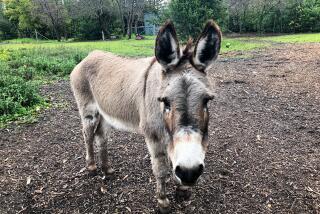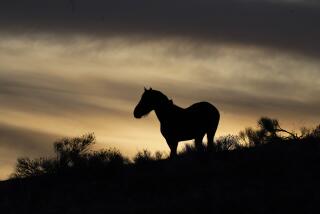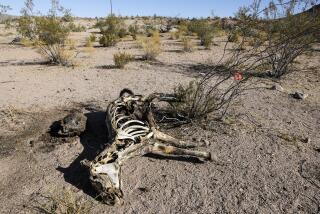Adoption Lines Form for Burros, Wild Horses
Nine-year-old Laura Riedman knew exactly what she wanted at the Bureau of Land Management’s wild horse and burro adoption Friday at Pierce College in Woodland Hills. And she found it.
The blonde fourth-grader chose a 6-month-old black and brown filly because “she was pretty, she looked calm, she had nice eyes, she had a strong back, she had straight legs and she had a good strong chest.
“I love horses,” said the gum-chewing youngster from La Mesa, east of San Diego. “They’re big and beautiful and fast and exciting.”
Riedman’s mustang had been rounded up in the high desert near China Lake, near Ridgecrest in the Mojave Desert, which the federal BLM says is overpopulated with horses and burros. The animals were trucked to holding pens in Ridgecrest and then to adoption sites. At Pierce, the BLM offered 75 horses for $125 each and 20 burros for $75 apiece.
Gene Nunn, wild horse and burro technician for the BLM’s Riverside District, said that because of a cut in federal funding, only one adoption will be held in Southern California this year and that many animals will be shipped for adoption to the East or Midwest. There were four adoptions in Southern California in 1989.
“There are more people who want them than can get them,” said Becky Borquez, state coordinator for the American Mustang and Burro Assn. “The problem is, why subject them to a three-day ride? They get cuts and bruises and banged up. They kick each other. I’d like to see them kept here.”
The donkeys, which is another name for burros, proved more popular than the mustangs. By midday, animal enthusiasts had claimed 11 burros, which are about the size of Shetland ponies, but only 16 horses.
The remaining animals will be available to the public from 8 a.m. to 5 p.m. today and Sunday.
A beaming Caren Woodruff of Fullerton was the first Friday to take home a donkey, a 2-year-old gray female.
“She started to walk toward me in the pen,” Woodruff said as her new animal kicked lightly against the side of the trailer. “She seemed a little friendlier than the others and I thought I’d have a better time teaching her.”
Gemini Herzog, a Pierce College student seeking a burro for adoption, said that since 1982, she has owned a pet donkey that she keeps at her home in Garberville in Northern California.
“She’s the greatest pet,” Herzog said. “She hangs out in the yard. You can put a pack on her. She thinks she’s a person. She’ll come into the house if you let her. She drinks soda from a can if you hold it. If you have a cup and walk by with it, she’ll drink out of that.”
“There is no such thing as an unadoptable burro,” Nunn said. “We have people who drive to our holding pen in Ridgecrest from Montana to get them.
“They are getting real popular as predator control. You put them with sheep and they run coyotes off. In the East, they will run off packs of dogs. And they are good for pets and pack animals. . . . They eat less than horses and they are real good weed eaters.”
Although the burros are popular, horse lovers such as Laura Riedman and her father, Dick, a Cal State San Diego professor, were equally pleased by the opportunity to take home a healthy mustang.
Riedman selected a 4-year-old steel-gray gelding that shook the metal rails of his holding pen and repeatedly kicked the wooden gate behind him before being allowed to run through a chute into the Riedmans’ trailer.
“I liked the way he moved and positioned himself with the other horses,” said Riedman, explaining why he selected the gelding. “Mustangs have qualities of durability that appeal to me.”
Observers said that with caring owners, even the wild mustangs would become good pets.
“Their experience with humans hasn’t been real terrific,” Borquez said. “In their first contact, they get rounded up by helicopters and placed in big corrals and freeze-branded on the neck.
“But once they build up trust, they are wonderful. I have a mustang mare who’s 4 years old and I swear if she could crawl into my lap, she would.”
More to Read
Sign up for Essential California
The most important California stories and recommendations in your inbox every morning.
You may occasionally receive promotional content from the Los Angeles Times.








